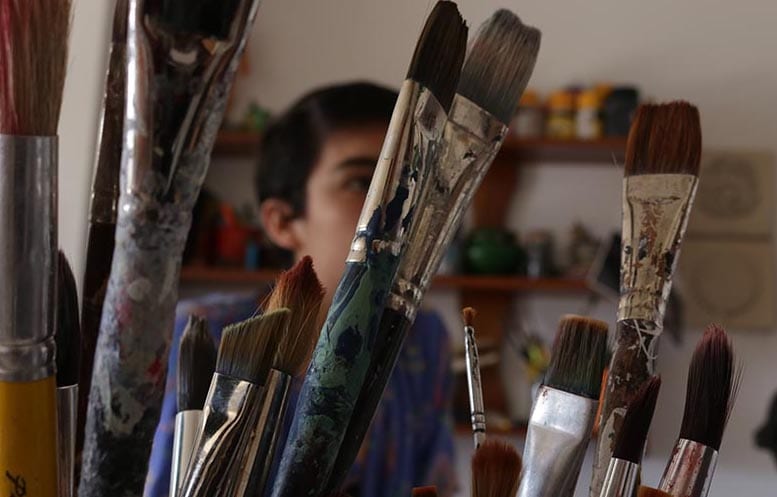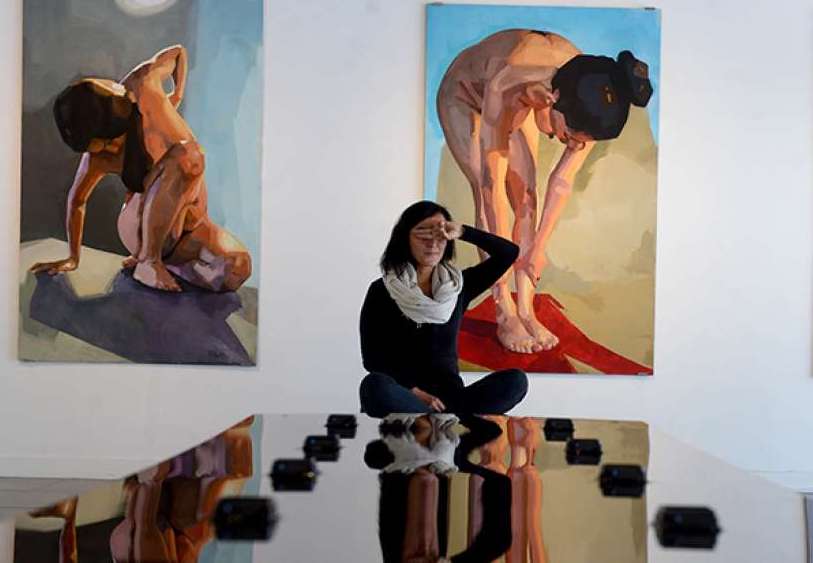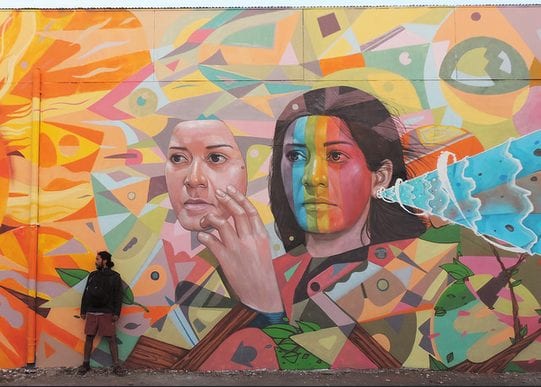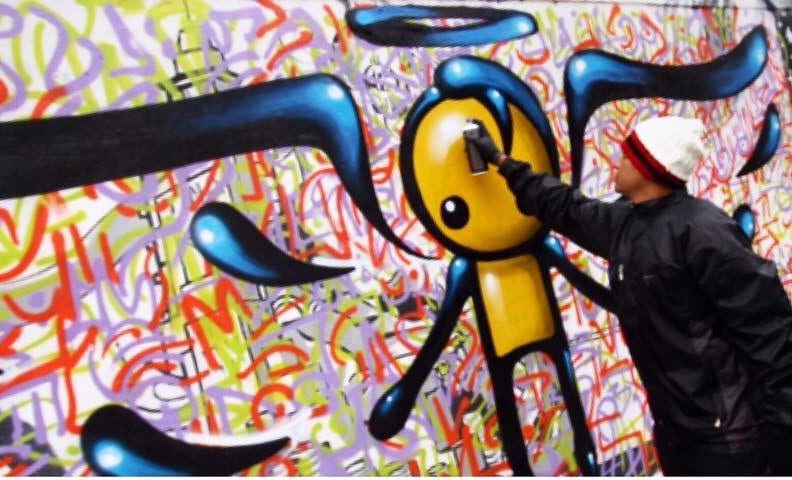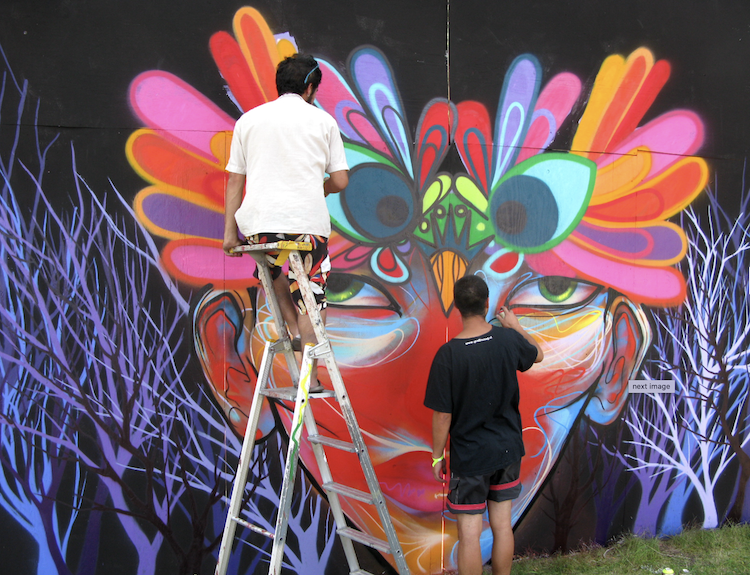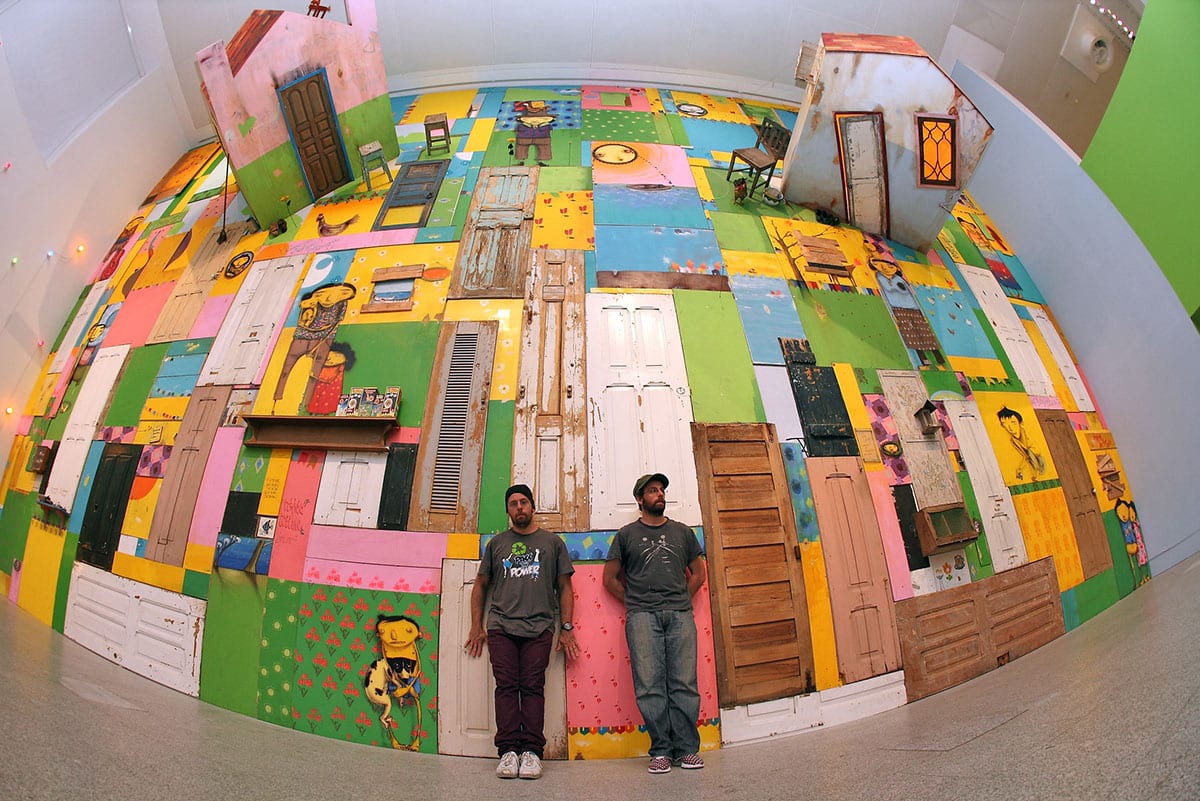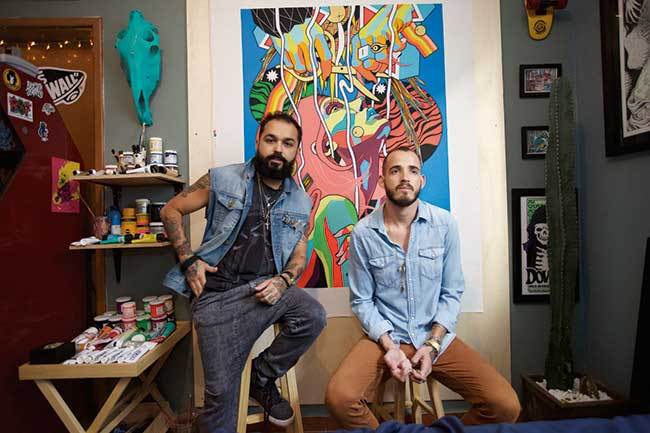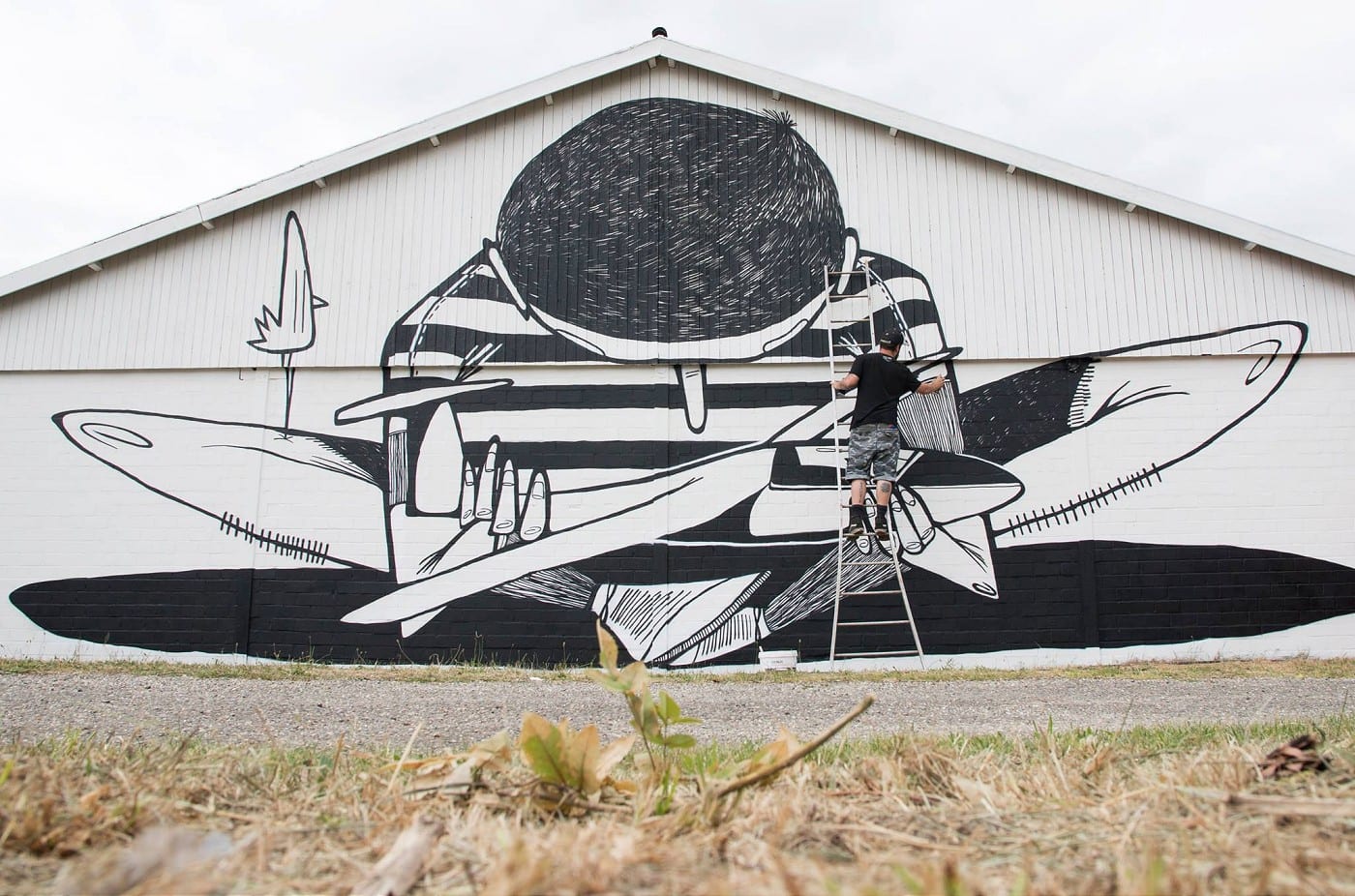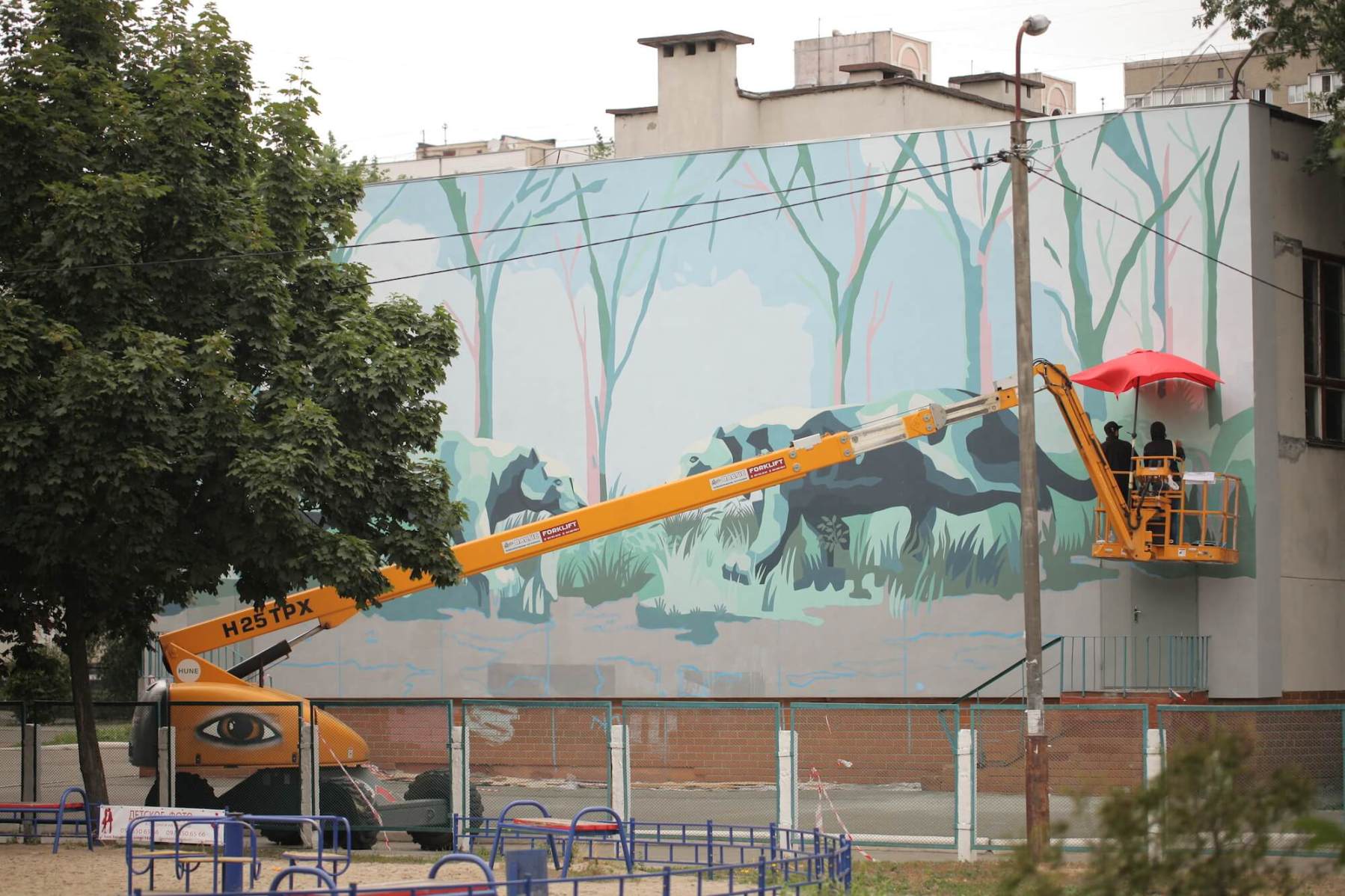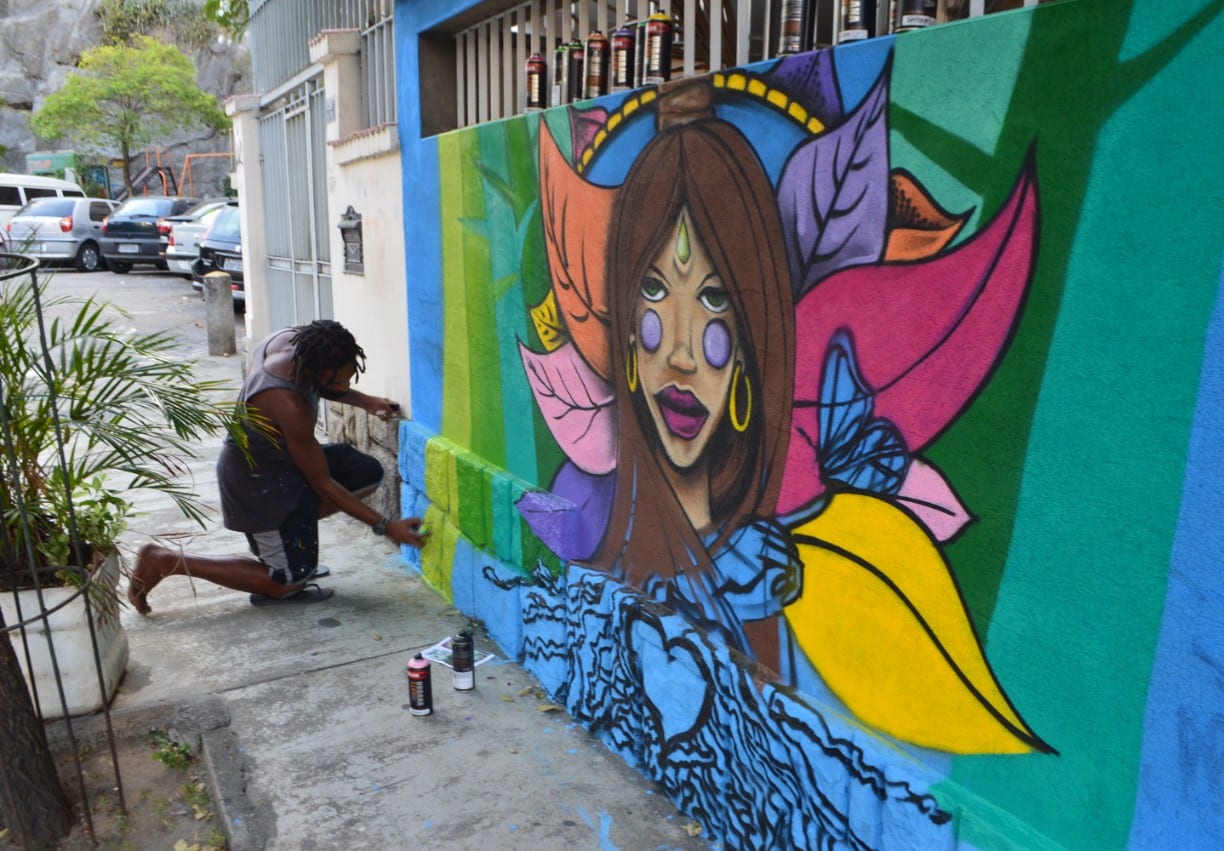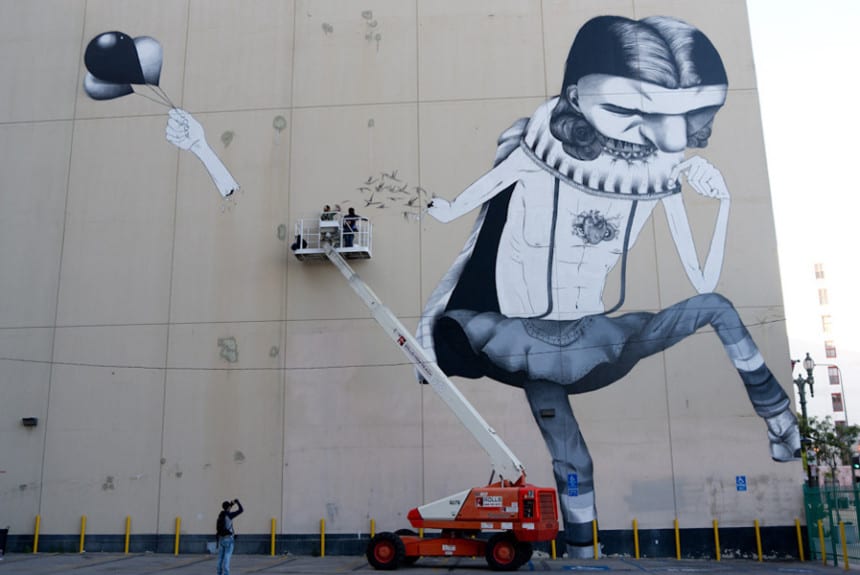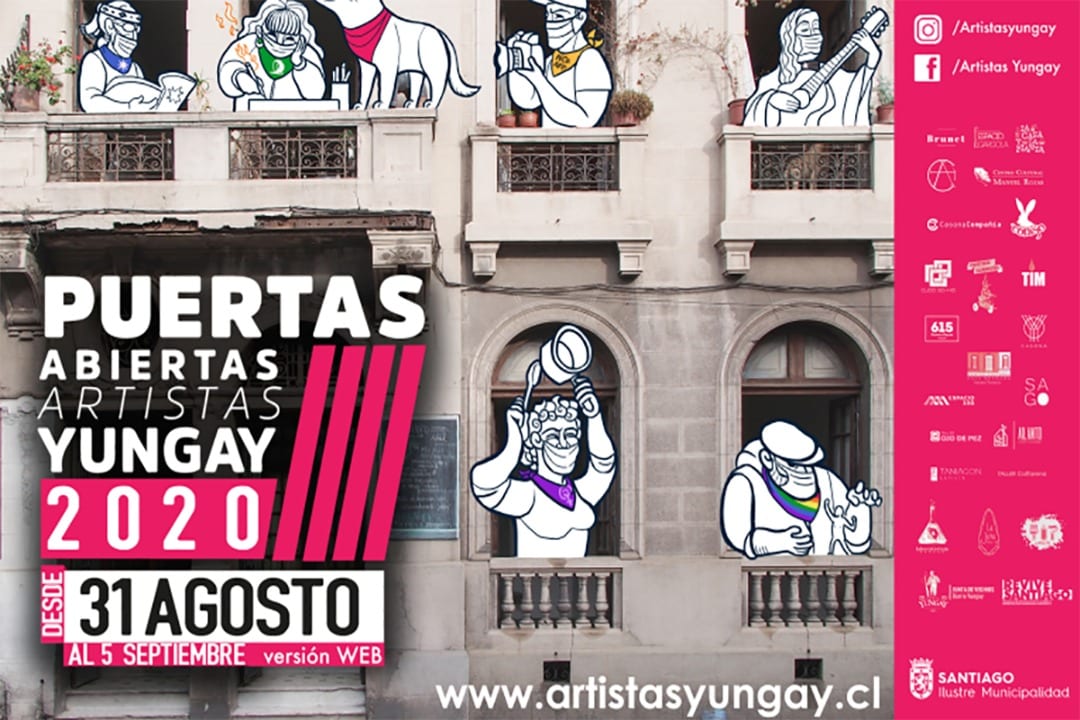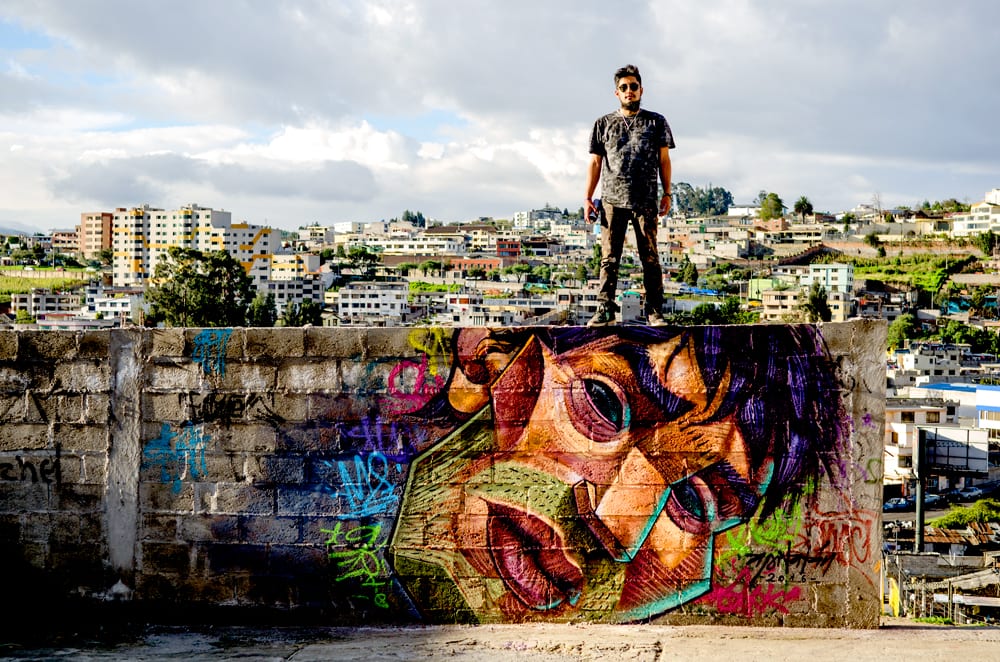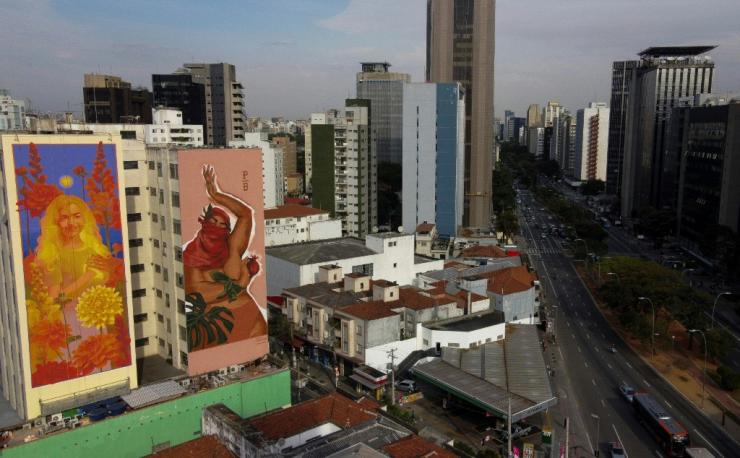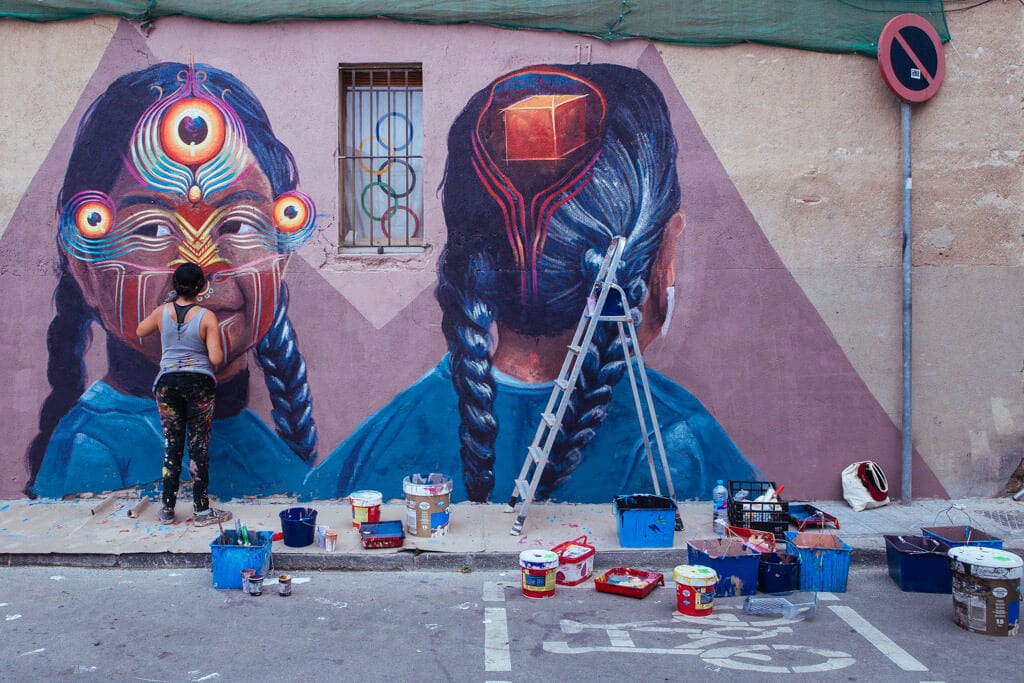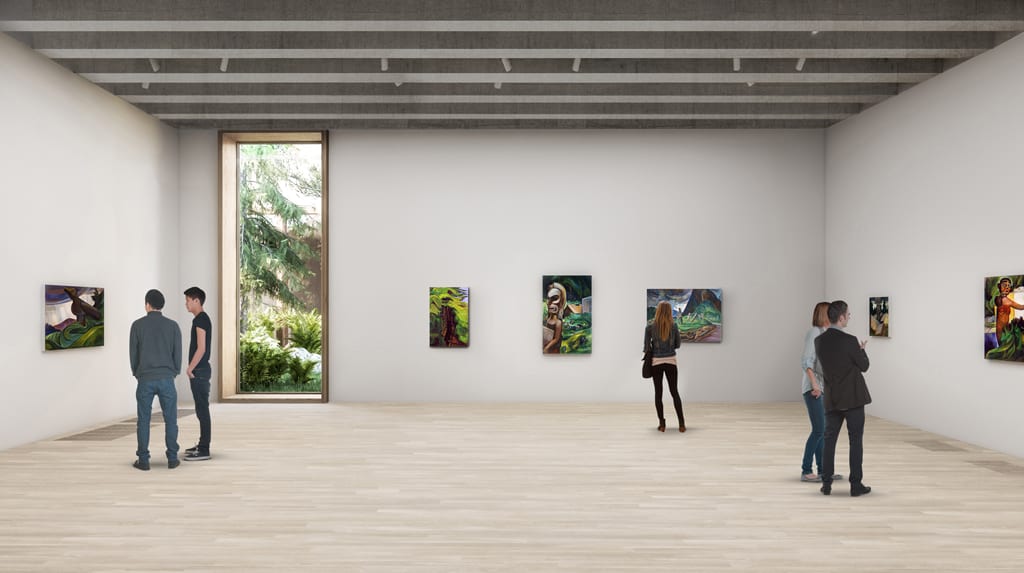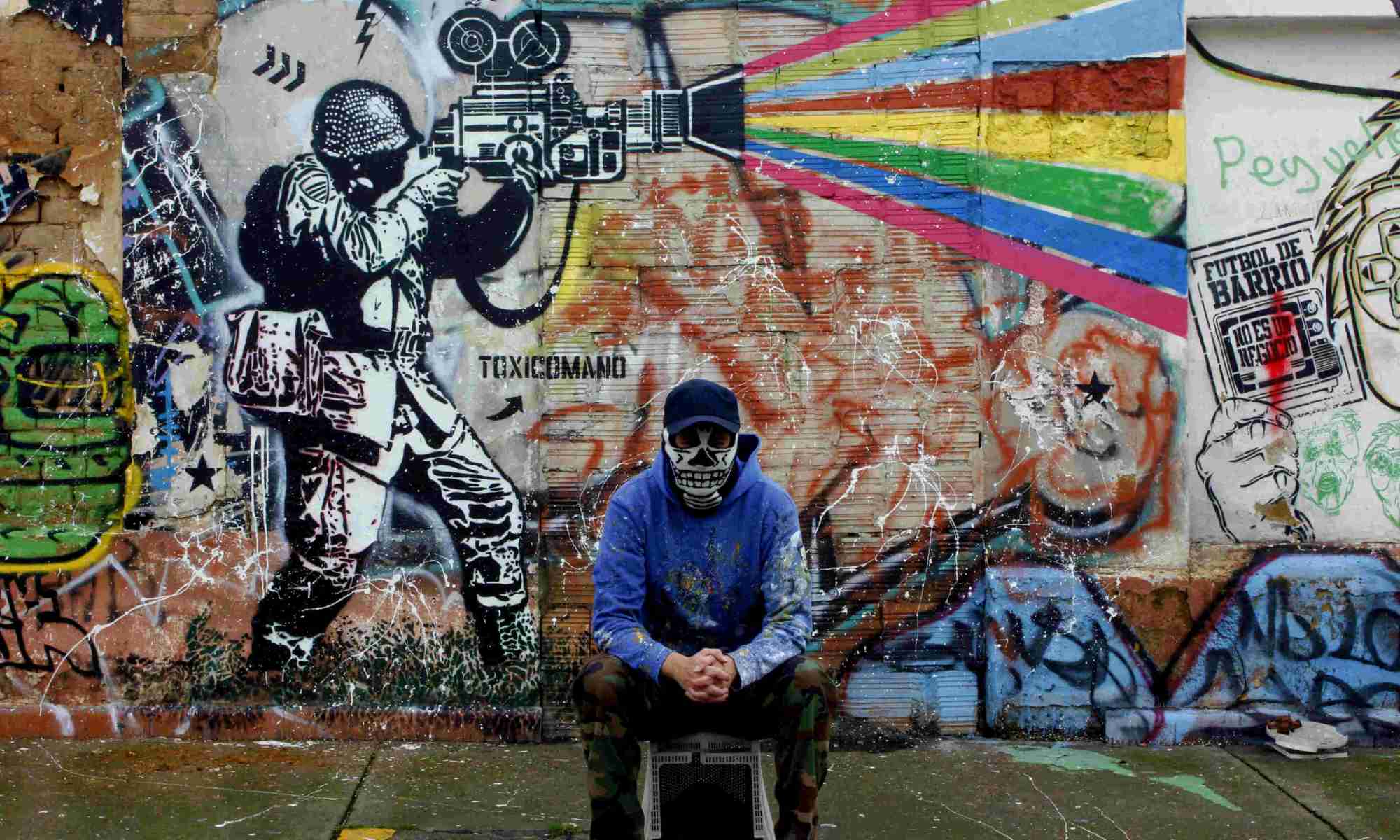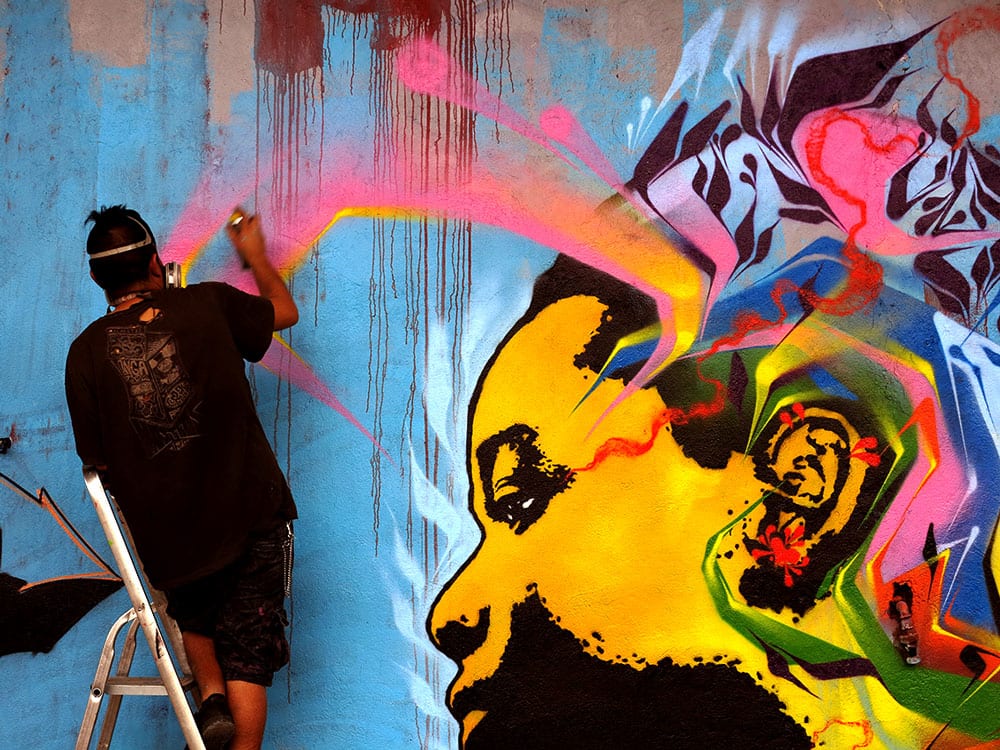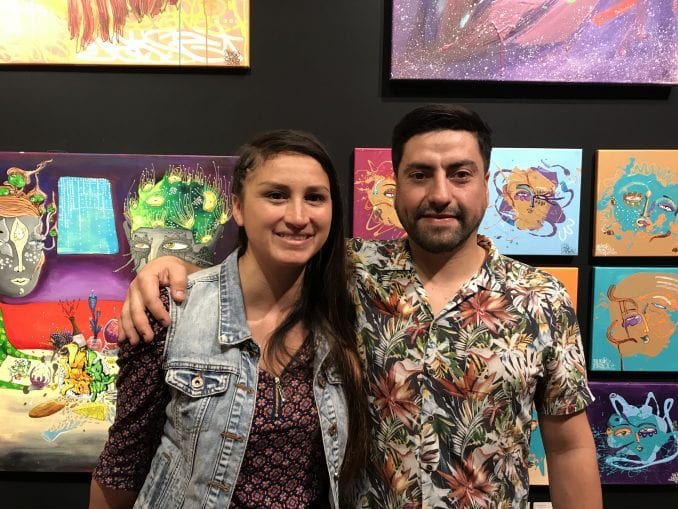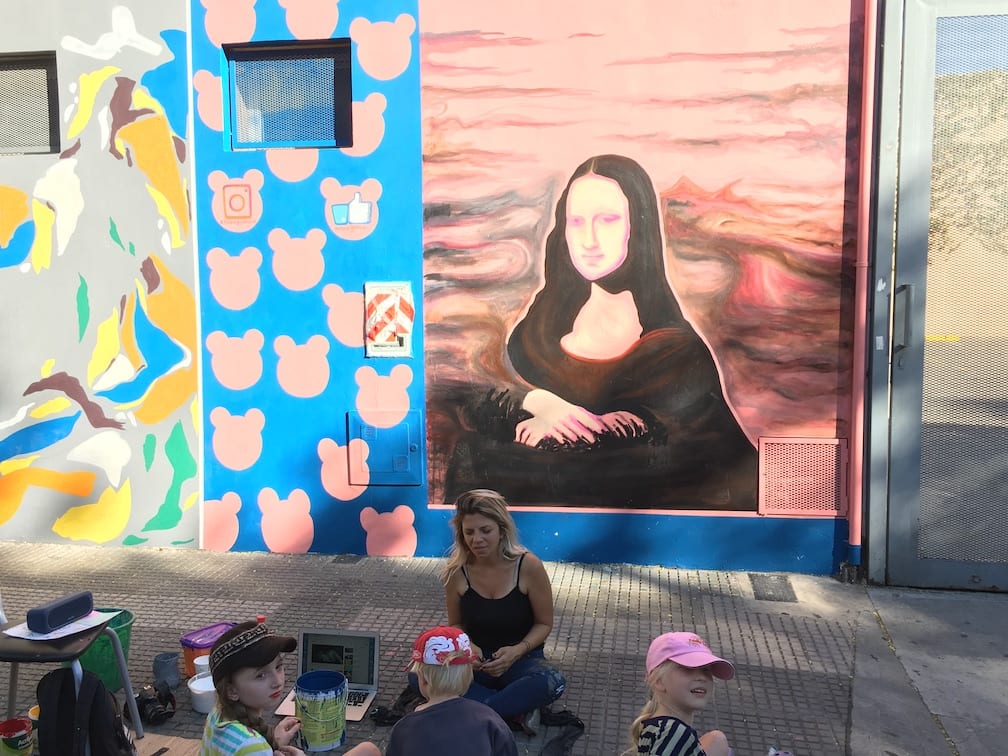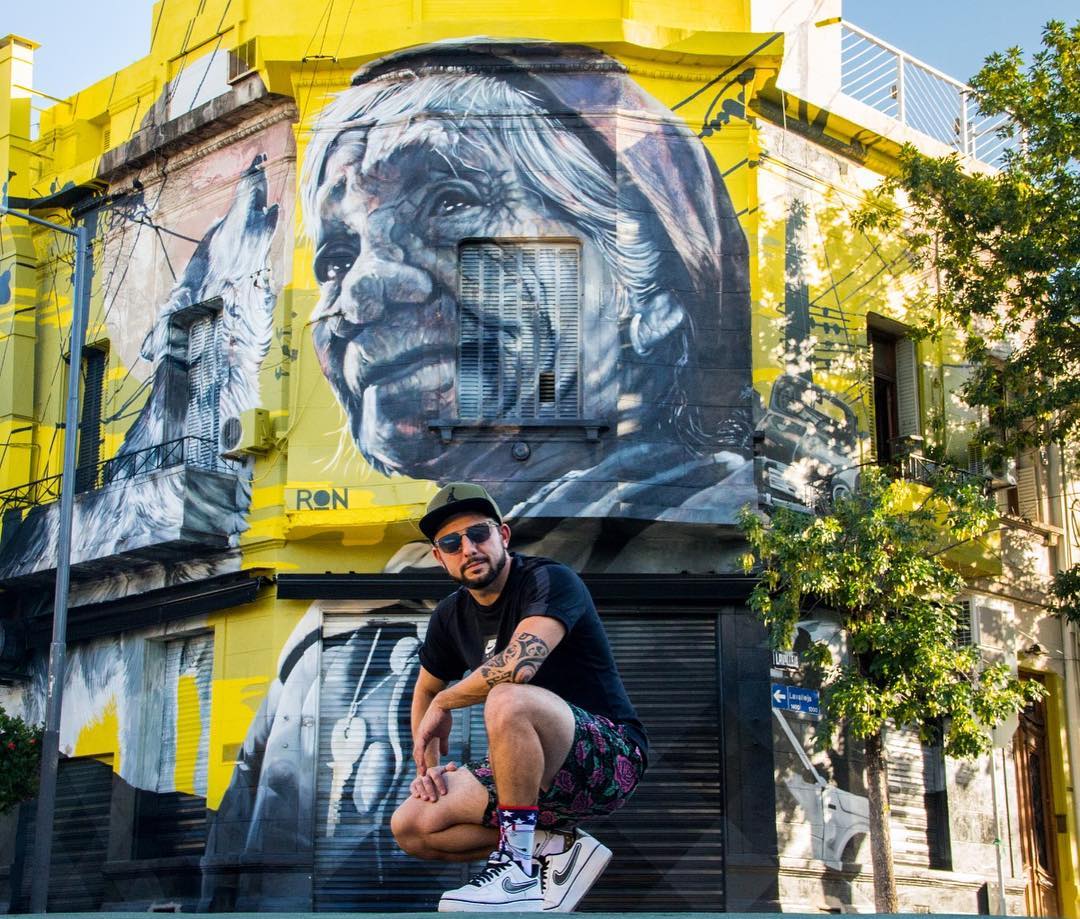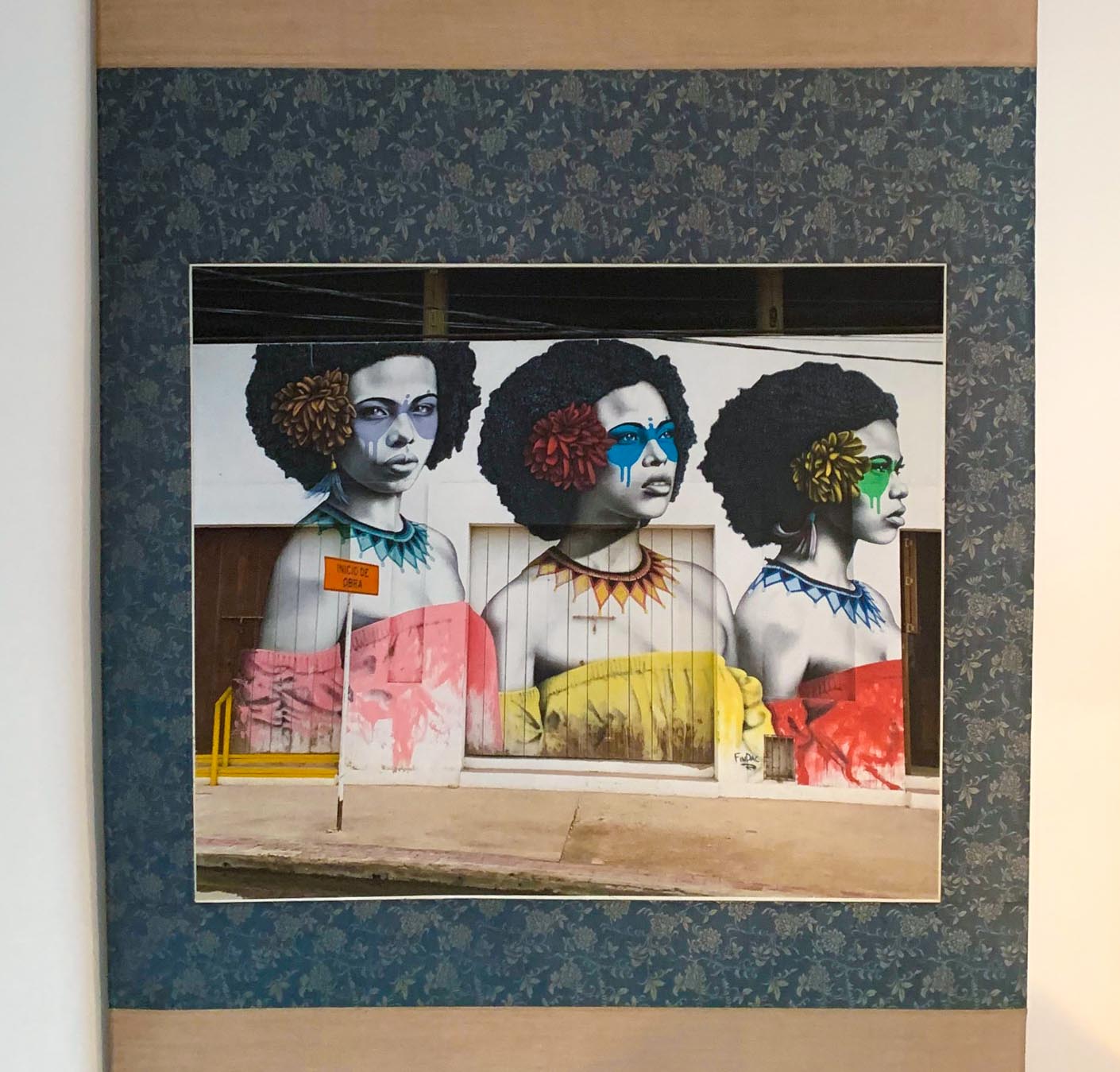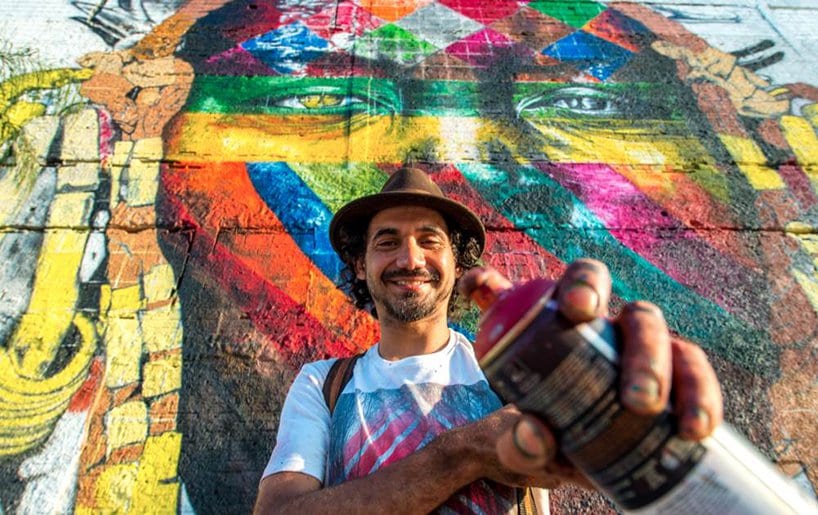Sofia Acosta (La Suerte)
Sofia Acosta is the real name of Ecuadorian street artist “La Suerte” (translated as “The Luck”). Apart from an urban artist, she is also a photographer and illustrator for several independent magazines and publications; and though she completed a degree in Philosophy in university, she opted to follow her passion for street art rather than a career in her chosen field of study. In her youth, she says that she met the urban artists Pin8, Ralex and EmeEse who she began to paint with while “learning the scene” from other artists in Quito.
Her grandmother, who painted in watercolor and oil, was an enormous art influence on Sofia when she was a child and they spent many summer days together painting. Acosta has said that through her art, she attempts to portray women in everyday life, while casting a light on what she describes as the fictional world created around women and their bodies. She is especially concerned by aggressive advertising campaigns where women end up being objects rather than subjects and what effect that has on society. In many ways, her work can be characterized by a certain rebelliousness that opts to paint women in diverse ways, without attempting to fit them into classical stereotypes of female beauty. Instead, she chooses to highlight many other beauty traits that run counter to the consumerist advertising model of female beauty. She considers her work to be highly autobiographical and her role as a woman, mother, artist, and activist are present in each piece she creates.
Her current style seeks to explore different materials, textures, and organic surfaces; sometimes incorporating garbage into a work as an expression of rejection and of reclamation of so much of our throw-away culture. Sofia regularly shares her new content on Instagram if you would like to take a look: https://www.instagram.com/l_a_s_u_e_r_t_e/
Belén Jaramillo (Bln Bike)
Belén Jaramillo, known as Bln Bike in the street art scene, is a renowned illustrator and muralist from Quito Ecuador, where she graduated as a Graphic Designer from the Metropolitan Institute of Design.
Belén showed great interest in art as a child and today continues to draw inspiration from several early sketchbooks that contain her first creations. Now she has more than 40 sketchbooks and continues updating her drawings in a quest to find the exact result she is after. A careful planner, while in the early phases of preparing to create a new work she does a careful audit of the space she plans to work in, taking pictures so she doesn’t forget any details, taking measurements of almost every inch of the wall and investigating every detail that seems like it may be relevant. Without a doubt, the term that best describes Belén’s art is “well-planned” and it is this careful and regimented process that seems to allow her to express her experiences, her relationships with other people, and her relationship with nature.
In addition to muralism, she does illustrations for publishers, video game companies, magazines, and advertising agencies. This has lead her to travel abroad to several countries where she has participated in festivals involving different urban spaces. At the time of writing this article, you can find her art in Colombia, Peru, Argentina, UAE, and Brazil, though we are sure there are now more countries to add to this list.
Belén’s most recent works can be seen on her Instagram account: https://www.instagram.com/blnbike/
Simon Arancibia (La Robot de Madera)
Simon Arancibia, better known as La Robot de Madera (translated as “The Wooden Fembot”) is a Chilean painter, graffiti artist and muralist. He began participating in urban interventions while he was a student at the Viña del Mar School of Fine Arts in 2007 (In close proximity to Valparaiso, Chile’s street art capital). He specializes in indigenous human forms and has taken his creations to numerous cities around the world.
His pseudonym comes from a comic he made out of boredom when he was just a boy in school. For him, it represents “achieving the impossible.” Although he uses the initials LRM most of the time, he continuously plays with his name to reinvent himself, using names such as Never, ROVOC, and Mr. L.
His career developed due to him being invited to participate in social murals of vulnerable sectors in Chile while still being in high school. After experimenting a couple of years with stickers and stencil techniques, in 2007, he formally arrived at graffiti while he was a student of painting.
His murals focus mainly on human beings and their internal thoughts, stemming from his research and tastes acquired through his travels: music, regional dishes, wildlife, traditional festivals, the church as a sign of human decadence, carnivals, dance, etc. Social issues also figure prominently in his art, as evidenced by a series of murals named “Los Estudiantes,” dedicated to the fallen youths in Chilean student protests, which led to the idea of education as a struggle.
Showing tremendous artistic range, Simon most recently has been experimenting with drawings of shapes that resemble natural elements such as coral or rock. His paintings are infused with a sense of mystery, as they tend to make us consider the hidden meaning they may have.
Simon has an Instagram account where we can check for updates on his most recent work: https://www.instagram.com/saintrobot/
Colombian Street Art Festival "Killart" Set to Take Over Barranquilla City
The sixth edition of Colombian urban art Festival Killart recently opened its sign-up process within the framework set out for cultural events in the city and adapting to new biosecurity measures due to the COVID-19 pandemic. Therefore, as in years past the urban art event is set to take over the city of Barranquilla, this year from September 23rd to the 30th in various parts of the city. Enrollment for participation is open until August 30th and the publication of participants will be on September 2.
Despite setbacks, they expect this year’s even to go ahead as in the past; continuing to revitalize the city with huge murals and transforming multiple city spaces such as a segments of Road 40 and an area near City Hall.
Over the years, the event has been a boon for dozens of local muralists who have had the opportunity to experiment and learn new techniques with the help of veteran artists. It has given them a chance to head up their own projects while hosting artists from other parts of Colombia and from abroad.
In its sixth edition, convened by the Alliance Française of Barranquilla, and with the full support of the District Secretary of Culture, Heritage and Tourism, Killart is set to go ahead as usual with a few necessary adjustments made in light of the pandemic. In this way, it will only have artists residing in Barranquilla and the municipalities of the metropolitan area.
The call for participation in the festival has three categories:
– Killart Street: A total of 5 artists will be chosen to paint murals on 5 walls in the public space with an open theme, where the artistic style of the participant can be appreciated.
– Heroes of the pandemic: An artist will design and paint a public mural to pay tribute to healthcare workers for their strong performance in response to the pandemic.
– Killart at the Cortissoz: Several artists will be chosen to paint murals that pay tribute to the evolution of the city. Winning murals in this category will depict its migratory history which affected culture, gastronomy, and the overall development of Barranquilla. An area of the Ernesto Cortissoz International Airport has been designated for these new artworks.
Through events like Killart, the city of Barranquilla continues to evolve its relationship with public muralists. Only in recent times has the public perception shifted to one that is more favorable and accommodating to this art form. We look forward to seeing the results of this year’s event.
Daniel Cortez (Decertor)
Decertor is the alias of the Peruvian artist Daniel Cortez, a self-taught painter active since 2005. Decertor got his start when he was following the rising hip-hop scene of Callao, a city near Lima considered by many to be a dangerous area. It is here that he met several graffiti enthusiasts who inspired him to start down the path towards becoming a street artist. Now, years later he has become one of the most renowned urban artists of Perú.
At some point, this artist adopted a pre-Columbian aesthetic, thoughtful and realistic, with his main influence being everyday life. His art aimed at representing the people, and his murals aimed at personifying those in society who deserve a better life and those who have come before who should not be forgotten. Under this slogan, Decertor began to receive commissions from ordinary citizens who wanted to commemorate their relatives in murals. Because the project had the added benefit of decorating deteriorated and abandoned spaces in the process, it became very popular. Eventually, his career led him to other cities around the world, and most recently, he joined a group of international artists who left their mark on the Dubai Street Museum Project.
Decertor has occasionally collaborated with several other artists, mainly Elliot Túpac (also Peruvian), an incredible lettering artist who paints brilliant 80s inspired posters that adorn the streets of Lima. Their individual processes have reached a point where they perfectly complement each other’s style, achieving unique results. Apart from Elliot, Decertor also occasionally collaborates with an artist known as Jade and the three of these artists together are the main actors in the urban art scene in Peru.
You can follow Decertor via his Instagram account: https://www.instagram.com/decertor/ or by checking out his Facebook page: https://www.facebook.com/eldecertor/
Marcos Rodrigo (Wark da Rocinha)
The Brazilian street artist Marcos Rodrigo signs his murals as Wark da Rocinha (meaning “Wark from Rocinha favela in Rio”). Notorious for poverty, crime, and makeshift houses and styles of living, Rocinha is Rio’s largest favela and Marcos is considered one of the first graffiti artists from this neighborhood to make it big. Even though he has built quite a reputation for himself now painting stylized angel figures that can be found all around Rio, he still maintains a strong connection to his roots and is known for his great social commitment to his community.
Marcos began as a self-taught artist and ended up studying at the prestigious Parque Laje Artist Schools (EAV), in Rio de Janeiro. Today he directs the Instituto Wark, a collective made up of artists, social coordinators, and professionals from different areas, which offers educational activities for children and young people from the favela.
Being a pioneer of Brazil’s largest favela graffiti movement, he quickly caught the attention and interest of Brazilians, from the humble to the most renowned. As a result, he found opportunities to organize numerous exhibitions and performances in the city and to have his works commissioned by major governmental institutions.
Wark’s graffiti is always expressive; using colorful stick figure angels created with simple lines, his graffiti and murals tend to depict his characters engaged in some kind of mischief. These can be found on practically all the streets of Rocinha and on all of the south side of Rio de Janeiro.
While many other artists have their sights set on the global spotlight, Marcos stays true to where he came from, less inclined to conquer the famous art museums of the world (which nevertheless keep inviting him regularly) and more interested in preserving the art of graffiti—stating that it is an important catalyst for change in poor neighborhoods.
Wark has an Instagram account you can follow to see his latest updates: https://www.instagram.com/warkrocinha/ You can also check out the Instituto Wark page here: https://www.instagram.com/warkinstituto/
Elliot Tupac
Elliot Tupac is one of the most renowned urban artists in Latin America. An expert in screen printing, calligraphy, and lettering; he has left his mark on cities across South America; a mixture of rebellious Chicha art (popularized by a musical movement in the 80s) and contemporary pop art.
With no formal education in art or design, Elliot learned everything he knows through the family tradition of Huancayo artisans, becoming a preserver and promoter of his craft. His spontaneous calligraphic style and colorful prints are instantly recognizable whenever you see one of his large murals. His pieces are filled with vibrant and overpowering colors and many appear almost indistinguishable from advertising poster. In them, you can find inspiring messages or slogans such as: “Peru isn’t Lima” “Before, I dreamed” “The power of blood” or “Love cures.” Often using metaphor and symbolism to evoke strong emotions from his viewers.
Elliot Tupac’s work and career have served to revitalize and re-contextualize the trade of draftsman; a popular profession in his native Peru as well as across South America. His work has been exhibited in a number of galleries in Latin America, the USA, Europe, Asia, and in the Middle East; and, he himself has participated in countless urban art events and helped develop conferences on art and Lettering.
With his own personal style developed through his early profession, Elliot continues to bring his unique vision of Peruvian culture to a whole new audience. If you want to see more, you can follow him via his Instagram account: https://www.instagram.com/elliottupac/
Sebastián Navarro (Charquipunk)
Strongly inspired by nature, Charquipunk (Sebastián Navarro) delights us with his vividly colored and seemingly moving pieces, bringing the cities he paints and their gray walls to life. A native of the coastal community of Concón, Chile; you will find most of his pieces in the street-art-Mecca of Valparaíso, just south of where he grew up. His passion began, as many things do, very modestly with some sketches he made during his free time. These he later translated into murals that can be found all across Chile.
Now, after almost 20 years in the street art scene he has quite a body of work behind him and the progression in his style and choice of subject is apparent. His earlier works tended towards realism, portraying animals and naturalistic scenes while blending in some elements of fantasy. Many of these pieces are based on folklore and contain imagery from various South America folk stories. Such representations are the most common among his murals, however, not the only ones in his thematic repertoire.
More recently he has become quite fond of painting birds and states that his home is full of books on the subject. In order to paint more convincing renderings, he has literally spent years studying, especially observing those native to his home of Chile. Another personal trademark is his use of felines, in honor of his pet cat. And one other style he has been using quite a lot in recent times is a sort of impressionistic technique where, using simple multicolor lines of spray paint, he creates stylized hummingbirds, animals, and natives wearing headdresses.
His love for nature has also led him to one of his personal projects, the so-called “láminas” or “plaques,” where he depicts an animal that is in danger of extinction; writing both its common and scientific names below the painting. Through this initiative, he has traveled to Peru, Portugal, Colombia, as well as to different regions of Chile; creating murals everywhere he goes.
If you are interested, updates on his works can be seen on his Facebook page at: https://www.facebook.com/sebastian.n.amaya
Gustavo and Otávio Pandolfo (Os Gêmeos)
Os Gêmeos (translated as “The Twins”) is a pair of twin brothers from São Paulo, born in 1974, whose real names are Gustavo and Otávio Pandolfo. Both graduated in communication and design and started painting graffiti in the 80s in the Cambuci neighborhood, where they grew up.
The duo gradually became one of the most important influences in São Paulo, helping to define the Brazilian street art scene. However, today their pieces can be found in cities in the US, England, Germany, and a number of other countries. Heavily influenced by Hip Hop culture, their themes range from family portraits to social and political critique.
One of the most significant features of their work is that, unlike many other urban artists, their canvas is not always limited to city walls. Often times they will utilize a number of surfaces, allowing them to guide the way the viewer experiences the artwork. In this way, seemingly insignificant elements and the streets where they are located are transformed into an outdoor museum for all to enjoy.
Key elements that characterize their work are a fine black outline stroke and the use of a wide color palette. In addition, their characters tend to be enormous, yellow in color often with uneven proportions, and somewhat cartoonish. They are apparently depicted in this way to draw attention to the most worrying aspects of the political and social environment in Brazil and in South America. Often times rhetorical references, metaphors, and paradoxes are used along with these figures resulting in a somewhat melancholic message tinged with frivolity.
The twins have managed to create a whole universe of their own and transport it to the streets of the world, where anyone can have a look. You can follow their Instagram page at https://www.instagram.com/osgemeos/ and be amazed by their sense of irony and clever use of environmental features.
Nicolás Romero (Ever)
Ever or Eversiempre (Nicolás Romero) is an Argentinian urban artist who started his career in the early 90s painting tags on the streets of Buenos Aires and stenciling cryptic messages for passers by to discover.
Since then, his pieces have grown in size and sophistication and now he uses the streets as a canvas, with paintings in every corner of Buenos Aires as well as in cities around the world. While at first glance his style seems similar to traditional styles of Latin American urban art, with a vibrant color palette and characters that reflect the local population; his use of spray paint and latex paint along with his surreal and oftentimes dreamlike imagery allows him to express unique forms of political, religious, and social commentary.
When he first moved away from graffiti he started working on faces, many of which were political figures. By experimenting with different styles and playing with techniques for symbolic representation he finally hit upon his trademark style; emanating jets of life represented with vibrant colors. One of his most characteristic features is the omission of his subjects eyes; in their place streams of color emerge, mixing with the different elements of his work and often connecting with the eyes of another subject in the painting.
Through his art, Ever realized he could express much more through his unique painting style than he could through words or through his early stencil pieces. And when set among pieces left by other urban artists in the past, and among features of the urban landscape, his street art interventions intermingle so as to amplify his message.
You can check out more of his artwork via his Instagram account https://www.instagram.com/eversiempre/
Luis Martins (L7M)
Luis Martins, also known as L7M, is a Brazilian artist producing work that goes beyond the norm of what we usually see in urban art. By mixing the organic with fractals and flowing, vivid colors, he has managed to come up with his own trademark style.
This young Brazilian artist started drawing at the age of 10 and had his first contact with a spray can when he was only 13, since then he has been experimenting and testing new combinations with materials such as pastel, acrylic, and Indian ink.
Birds being his major subject, he uses his stylized technique to recreate ducks, sparrows, owls, and other avian-themed murals on the streets of Sao Paulo and other major cities around the world. He represents his birds materializing out of chaotic swirls of dripping paint with sprayed on stencil fractals. His varied use of vivid colors contrasting colors creates a clash of both the abstract and figurative, highlighting the difference between the concrete of the city and the organic softness of natural elements he depicts. Luis Martins has stated that he finds these creatures fascinating because to him they represent a kind of freedom; the same kind of freedom that has allowed him to paint and travel the world, spreading his art anywhere he goes.
Without a doubt, L7M has become one of the most relevant figures of street art in Brazil and the world; he has continued to amaze us with his art throughout the years. You can follow L7M on his Instagram at https://www.instagram.com/l7matrix/ and on Facebook https://www.facebook.com/L7matrix/
Douglas de Castro and Renato Reno (Bicicleta Sem Freio)
Bicicleta Sem Freio, a name that can be translated as “Bicycle Without Brakes,” is a collective organized by Douglas de Castro and Renato Reno, two great Brazilian illustrators and muralists. Their artwork tends to be colorful, illustrative, polemic, and very stylish.
Founded in 2003 and primarily inspired by rock and roll, fashion, graphic design, and beautiful women. They became internationally famous for their hand-drawn illustrations and large-scale murals in cities around the world. Apart from in Brazil and a few large metropolitan areas in South America, their pieces can be found in London, Berlin, Hong Kong, Miami, Las Vegas, Montreal, and Los Angeles.
By comparison their style seems somewhat sophisticated, layering in many different elements and ideas, often with ironic references to comics, cartoons, and global pop culture. The resulting chaos and harmony blend to create eye-catching and captivating compositions.
In addition to their street art illustrations and provocative murals, they also do collaborations with a number of brands including Nike, NBA, UFC, Converse, and Vans; and have also produced concert posters for bands including: Beck, Kings of Leon, and Vampire Weekend.
You can see more of their works on their Instagram page https://www.instagram.com/bicicletasemfreio/ and on their official website https://www.bicicletasemfreio.com/
Alex Senna
Alex Senna’s work is born out of the language of illustration, comic books, and graffiti. Based off of these genre, he builds in to each piece a story with an important poetic or entertaining message. For the last few years, he has been especially focused on observing human relationships in order to portray them in his paintings.
Deceptively simple in appearance, many of his murals include symbols that we have all used in our drawings since we were kids; things like birds, musical notes, hearts, trees, a sun in the sky… Another interesting feature that characterizes his art is that he always paints in black and white; not out of preference necessarily, but rather due to the fact that he is color blind.
Using a minimalistic graphic style, due to his influences, and a minimalistic color palate, due to his color blindness, Alex Senna has filled countless city walls, shops interiors, and other vertical surfaces with his uniquely rendered heartwarming scenes. Through his urban art, Alex is able to establish a sort of dialogue with passers by. His use of characters such as couples, grandparents or melancholic people appearing in day-to-day activities invite the viewer to reflect on their own life experience.
This Brazilian artist affirms that his purpose is to help us remember in our day-to-day lives familiar moments that have helped shape our character; for example, couples enjoying each other’s company, friends conversing, a special moment in time, a romance, an emotion… In this way it is his hope that people are able to put aside the stresses and obligations of life in order to let themselves be carried away by fond memories or by the moment at hand.
Senna regularly updates his Instagram where you can view his previous and most recent works: https://www.instagram.com/alexsenna/
Franco Fasoli (JAZ)
Argentinian by birth, Franco Fasoli, is an urban artist who signs his numerous works spread around the world with the pseudonym “JAZ.” His style along with the themes he paints speak to the ideas of competition, struggle, and identity—all tinged with a sense of irony.
Born into a family of artists, Franco went through formal training to become a set designer and worked for a time at the prestigious “Teatro Colón” in Buenos Aires, a job that taught him a variety of skills such as sculpture, carpentry, and painting. Even today you can see the influence this experience had both on his technique and on the style of scenes he paints.
One of the first urban artists active in Buenos Aires, in the early 90’s he was drawn to muralism and adopted a more stylized approach. At first, his works depicted a number of icons from Argentinian culture but later he started painting animals, people, and chimera (part human part animal) as a metaphor for raising political and social questions. His characters are often seen locked in struggles, symbolizing the way modern people often have to fight for their identity, social standing, and political preferences.
People often credit JAZ with being responsible for the recent boom in Argentinan street art, though he prefers to call the phenomenon a “resurgence of Latin American muralism.” He goes on to say that It is difficult for him to identify with the muralist tradition of the 20th century because “they were working towards a specific political agenda”, while the murals of the 21st century reflect popular culture, the internet, and ideas that come from globalization.
You can follow the most recent updates on his Instagram account at: https://www.instagram.com/francofasolijaz/
Rio de Janeiro Prepares to Host the Rua Walls Event
In September, Rio de Janeiro will host the Rua Walls event, an open and accessible public art project with the participation of 18 urban artists. Together, they will transform 1.5 km of city walls along Rodrigues Alves Avenue into works of art. Starting from August 22, each participating artist has one month to complete their mural, with the exhibition scheduled to start on September 27. The urbanism project was created by the production company Visionartz, which, for more than 10 years, has been developing urban revitalization projects in the region using art as a social development tool.
More than an art exhibition, the initiative serves as a tool to revitalize the region and stimulate the local economy; more important this year than ever considering the impact the coronavirus has had on the economy. The paintings will leave a lasting mark on the community, to be enjoyed by locals and visiting tourists alike.
The project provides locals with the opportunity to learn about works by some of the most talented visual artists of the urban art scene. In recent months people have been avoiding the outdoors but the project will eventually serve to help people relax in the urban environment once things return to normal.
Among names confirmed for participation in the event are: Agrade Camís, Amorinha, Bruno Lyfe, Célio, Chica Capeto, Diego Zelota, Doloroes Esos, Flora Yumi, Igor SRC, Leandro Assis, Luna Bastos, Mariê Balbinot, Marlon Muk, Miguel Afa, Paula Cruz, Thiago Haule, Vinicius Mesquita and Ziza.
With the COVID-19 pandemic still raging and Brazil being especially hard-hit, health precautions have been increased, and production teams will be following recommendations set out by the Ministry of Health. The majority of paintings will be done during the night, while the avenue remains closed to traffic.
Claudio Rafael (Ethos)
Claudio Ethos (born in São Paulo, 1982), is a renowned Brazilian urban artist with an amazing collection of impressive large-scale murals. Employing a very unique style, his fanciful and bizarre characters―often rendered in 3d―tend to transform the places where they are located.
Starting at the age of fifteen after lots of practice scribbling in notebooks―as time passed Claudio’s murals increased in size and complexity as he perfected his unique surrealist style. Today he is one of the most recognized figures in the street art scene with murals not just in Brazil but in cities around the world and a number of exhibitions under his belt.
Not only the scale of this work, but also the way his illustrations tend to utilize a minimalistic color palette never ceases to amaze us. His style is meant to connect the viewer with the surreal and unconscious energy of the city and many of his characters are depicted as either anxious or struggling. He is quoted as saying that his characters are meant to depict emotional and spiritual states with no accurate definitions. Much of what he paints is captured through observing the world around him and trying to translate what he sees into images using his intuition. Now with 322 posts as of the writing of this article, Claudio Ethos’ numerous creations can be admired via his Instagram account at @claudioethos
Álvaro Córdova (Tnaz)
Álvaro Córdova (better known as “Tnaz”), discovered his talents and tastes for painting at an early age. Experimenting with drawing and with colors was something that helped him discover his identity, not just as a resident of the place he inhabits, but also as a member of the native population. Being part of society that has, since the beginning of colonial times, been viewed as lower in the social hierarchy was a strong motivating force for him as an artist. Therefore, it seems no coincidence that his name is phonetically similar to the word “tenacity” in English.
Ecuador (where Tnaz is from) is a country with a strong indigenous presence–with more than twenty indigenous communities in the central mountains, along the coast, and in the Amazon basin to the east. The murals Tnaz paints proudly portray his ancestral heritage as part of the Peguche native community.
Being a strong believer of the saying, “Never forget where you come from and where you are going,” respect for his ancestors is visible in his aesthetic. Wearing the long braid common among his people is one way he connects with mother earth in order to pay homage to the place where he comes from. Meanwhile, his clothing also follows a certain code: long shirt, wide pants full of paint, headphones to listen to music, and more recently a gas mask to avoid breathing in fumes from the paint has become part of his look.
A dominant feature expressed in many of his murals is a kind of mythical romanticism–one that apparently comes from the aura of actual people he has met in different indigenous communities. His highly polished technique allows the lines and colors of the image to stand out in a way that quickly catches the eye. For Tnaz, there is no more beautiful feeling than seeing the reactions of the people in front of his murals, especially those of the community’s elders, who smile when they see their culture portrayed in public spaces. A surprising fact considering that not long ago graffiti and street arts were synonymous with vandalism and crime. These days he says he frequently receives offers to do commissioned paintings on canvas; however, for now at least, prefers that everyone is able to enjoy his creations, and therefore refuses to put his pieces in galleries.
Tnaz has definitely proven himself to be one of the most fascinating figures in street art and without a doubt brings a completely new perspective to the table with his work. You can check out his recent pieces on Facebook at TenazGraff and Instagram at @tnaz.graffiti
In Perú, Urban Artist Daniel Manrique Barzola Honors Covid-19 Victims.
As of August 16, Covid-19 has killed 772,000 people worldwide and in South and Central America several countries have been especially hard-hit by the virus including Brazil, Mexico, and Perú. With a population of 33 million inhabitants, Peru has now reported over 22,000 deaths and some feel this figure might not reflect the true number of deaths as many have gone unreported.
While health workers of all nations desperately seek a vaccine to contain the crisis, many citizens have started focussing on ways to pay tribute to victims who lost their lives to the disease. Such is the case of Peruvian muralist Daniel Manrique Barzola, who has been painting portraits of local victims of Covid-19 on the walls of his neighborhood to send a message about the impact the pandemic has had on his community.
Daniel explains that the initiative arose out of concern for his fellow citizens―many of whom initially refused to comply with sanitary measures―and the need to alert them to the actual danger posed by the virus. To do this, he decided to start painting murals to let people know about all those in the neighborhood who had died from the disease. Now the streets of Rímac, Lima are beginning to fill with portraits of the deceased; on one wall the face of a 20-year-old young man, on another a 72-year-old woman, and sadly, the face of his niece on another. All victims to the recent virus.
Because he has been painting in the community for more than 22 years and is well-known to his neighbors, his message has surely helped slow the spread of the disease. To help deal with his own great sense loss and to assist in healing his community, he has started visiting the homes of the relatives of the deceased and giving them small paintings of the loved ones they have lost.
"Puertas Abiertas" to be Held Online this Year
This year the fourth edition of “Puertas Abiertas” (Open Doors) will be held online. This is an event in which artists from the Yungay neighborhood of Santiago de Chile integrate the community into their creative processes by showing participants how murals, sculptures, and serigraphs are made. Puertas Abiertas has more than 40 visual artists in its ranks who hope to help satisfy people’s curiosity, deepen their knowledge, and help promote access to arts and culture. The event lasts for one week and is completely free of charge to the public.
In past years the event actually took place live, with a number of organized events and gatherings. This year however, given the healthcare context, the meeting has been adapted to an online version in which visual artists share their presentations with the public from their workshops via live streaming. The event begins at 4 PM on Monday, August 31st and ends on Saturday, September 5th.
You can also check the programming on www.artistasyungay.cl, and follow them on Instagram and Facebook at “Artistas Yungay,” to be part of the experience.
Juan Sebastián Aguirre (Apitatán)
Juan Sebastián Aguirre, better known as Apitatán, is an Ecuadorian urban artist, graphic designer, and illustrator who, in addition to filling local and foreign street with art, strives to generates a sense of surprise with his work.
The first thing you notice when you encounter one of his paintings is his use of language and especially the way he uses everyday Ecuadorian sayings in the local vernacular to evoke surprise. Next is his use of humorous characters with exaggerated features and bright colors that border on the cartoonish. Seeing one of his pieces is to enter into the domain of the unexpected and will likely put a smile on your face.
Although he defines himself as a professional painter and illustrator, he maintains that it is important for him not to get hung up in the details or to focus too much on the technical aspects of his work. Instead, he finds a “go with the flow” attitude of painting murals in the streets to be an antidote to the meticulousness that sometimes, at a desk or in front of an easel, tends to slow down his strokes.
Through his witty sarcasm and unique engaging style, Apitatán has proven himself to be not just an urban muralist, but also a representative of his time and nationality, making him one of the most outstanding of his generation. It is also worth mentioning that he sometimes uses his medium to show support for modern struggles like same-sex marriage, and that this has occasionally brought him into conflict with the local community and with the authorities.
If you want to check updates on his works, you can check his website: https://www.apitatan.com/murals and Instagram account: https://www.instagram.com/apitatan/
Nati Andreoli & Lina Castellanos (Dúo Amazonas)
Dúo Amazonas is a collective of street artists organized by Nati Andreoli and Lina Castellanos; the former born in Argentina and the latter in Colombia. Both of them have professional degrees and backgrounds in Scenography (the art of set and stage design) and have been quite active in the last few years.
One of the most common themes in their pieces is the presence of women with an emphasis of their social positions. They have participated in recent pro-feminism art events like the Delas Fest (in Galicia, España) where they contributed the piece “Xa Pasaron as Leiteiras” (The Milkmaids Have Already Passed) , an homage to working-class women.
Dúo Amazonas originality continues to amaze us with their recent take on the quarantine situation as depicted in their work “Cuarentena.” This piece displays an image that reflects one of the most important communication channels during these times, the video call. With the recent need for social distancing, this has become a vital communication tool to maintain emotional ties between friends, family, and professionals. The work is composed of two images from a video call, portraying the two artists communicating in this way.
You can follow Dúo Amazonas works on https://www.instagram.com/duoamazonas/ or via the member’s accounts @chunchullo and @nati.andreoli.
Leticia Mandragora
Leticia Mandragora is an Italian/Spanish urban artist and tattoo artist who began leaving her mark on cities around the world when she was just a kid. Moving to Naples at a young age she quickly searched out alternative communities that would allow her to express herself freely and, around this time, began experimenting with spray paint and the urban canvas. Many years later she has developed a style of her own and has become an influential figure on the modern street art scene.
One of her most recognizable themes is a hyperrealistic drawing of a woman with pale blue skin she describes as being a figure elevated to an ethereal and unreachable plane. Filled with bold colors that stand out against these blue skinned goddesses, her pieces tend to draw attention to difference by continuously changing the ethnicity and age of her subjects. Sometimes she depicts them as old women and sometimes as girls; sometimes with Asian or South American features, and sometimes looking more European.
Though not a South American artist by birth, we include her here because we came across one of her murals in Santiago de Chile in 2018. Unfortunately, the piece only lasted a year or so before being vandalized and later painted over. Luckily we found it before all of this happened so if you would like to see it check out our gallery where we have preserved an image.
As we mentioned at the beginning of the article, apart from her work as an urban artist Leticia is also a skilled tattoo artist with a distinctive style that you can check out on her social media accounts here —- > https://www.instagram.com/leticiamandragora and https://www.facebook.com/leticiamandragora/
Findarr Dac (Fin Dac)
Although this artist is not South American, we were always impressed when we came across one of his murals and we particularly admire “Las Tres Guerreras” in Cartagena and his collaboration known as “Splash” with Angelina Christina in São Paulo.
Findarr Dac, popularly known as Fin Dac, is a self-taught urban artist who was born in Ireland, raised in London, and who (we are told) resides part-time in Dublin. From an early age he showed a remarkable interest in art, with the intention of some day becoming a graphic designer. For various reasons he never completed a degree but rather realized his creative aspirations through painting remarkable works of street art in cities around the world.
Easily recognized by his trademark black and white “geisha” who are often dressed in vibrant clothing and make-up that masks the wearer and creates a unique contrast that always catches the eye. Another feature of his work is the use of a technique known as “urban aesthetics”—a spray paint style consisting of urban stencil art combined with traditional portraits that he has perfected over the years. When asked about his influences, he admits that gothic graphic novels and Aubrey Beardsley illustrations in particular have inspired his work greatly.
In a relatively short time, Fin Dac has managed to become one of the most influential and recognizable street artists around, leaving his mark on four different continents and proving that street art is a call that artists must let themselves follow wherever it leads them.
Fin Dac continues to astound us and if you want to see what he’s been up to recently have a look at his Instagram here — > https://www.instagram.com/findac/.
With 12 New Murals, São Paulo Continues to Churn Out Urban Art Pieces.
Amid the COVID-19 pandemic in Brazil, and with art galleries still closed, São Paulo proves once again why it is the world’s epicenter of urban art.
Planned as part of the “NaLata” Festival–and thought by many to have been postponed due to the pandemic–the project to paint 12 new murals in the Pinheiros neighborhood of São Paulo is still going forward. With many of the new pieces taking shape, they look to be completed in due course despite Brazil being hard hit by the virus.
One of the participants, Mexican painter Paola Delfín, recently finished a mural she started working on over one month ago. The piece is of the face of a woman rendered in different shades of gray. Meanwhile, renowned artist Enivo is working on the largest piece of all, a technicolor figure carrying a cat in his arms and wearing an indigenous headdress with feathers that are actually spray paint cans. This mysterious figure is depicted wearing a long skirt with the Brazilian flag whose motto “Ordem e Progresso” (Order and Progress) has been replaced with the words”Tempo Novo” (New Times).
Apart from Paola Delfín and Enivo, many other popular street artists have joined in the festival including Marcelo Eco, Alex Senna, Pri Barbosa, Evol, Mari Mats, Mateus Bailon, Rafael Sliks, Colombian artist Gleo, and five graffiti artists recently selected in the “Novos Talentos Murais SP” (New Muralist Talent Contest).
When completed the project will represent the largest graffiti complex in the country, with 3,689 square meters painted in total.
Nathalia Gallego (GLEO)
Nathalia Gallego, commonly known as “Gleo,” has become one of the most prominent figures of the modern South American street art scene. Her murals can be found not only in Colombia (where she is originally from) but in a number of other countries in South America; and, more recently, in place like Montreal where she completed a large mural called “Metamorphosis” as part of a street art festival in 2019.
Starting at the age of 17, with what she has described as an impulse for painting figures of sea creatures on small murals of her own neighborhood, she has quickly escalated while developing a recognizable style of her own. Her compositions often feature pre-Columbian figures, like dark haired men and women with their faces painted with lines or strange patterns and hair decorated with floral ornaments, in combination with her distinctive mark, one or more prominent bright yellow orbs that look like eyes that she describes as a representation of the constant transformation of energy, a symbol of natural cycles and of the infinite.
Though she is most known for this trademark style, she is not limited to pre-Columbian figures, also showing modernly dressed people and even her own take on ancient greek paintings, but, of course, almost always using her distinctive bright colors and yellow eyes.
We are always looking forward to new pieces by this artist and we recommend checking out her Instagram to see her most recent works: https://www.instagram.com/gleo_co/
Exhibitions
At the moment we are hard at work creating high quality art prints on Japanese paper (washi). Some of these we are mounting on antique hanging scrolls and some we are using a special process to mount unframed. When the first group of pieces is complete we hope to have 20-30 in total and will then be looking to exhibit as widely as possible. So, as you may imagine, now we are reaching out to galleries and other venues that seem like they would be a good fit for this type of project. If you like the pieces we are creating, would like to help support this project, and have access to gallery space or connections to exhibition spaces feel free to contact us and let us know. Thanks in advance for your support ~
Andrés Montoya (Toxicómano)
Growing out of the Bogota Punk scene and lead by graphic designer and activist Andrés Montoya, the collective known as “Toxicómano” has been producing edgy and politically motivated works on the streets of Bogota for decades now. One of their most controversial and dramatic pieces was a giant black skull painted in 2017 with the message “Peligro de Muerte” (In danger of dying) and a counter that was repainted every time another victim died of political violence. The demonstration lasted one month and was designed to denounces the murder of social leaders in Colombia–especially in rural areas–who were thought to have been assassinated by state forces who saw them as being obstructionists and a threat to state power. Apart from intensely political statements like this, the majority of the pieces they create carry messages like “somos de todos” (we are for all) and “los feos somos mas” (we the ugly are better), a populist message designed to make people think more deeply about all the marketing and image manipulation they are exposed to. Although they are not completely anti-capitalist and describe themselves as for-profit punks, their message is definitely in opposition to large-scale imperialistic capitalism that they feel monopolizes public image and exploits the many for the profit of the few.
(Stinkfish)
Based on the sheer volume and size of the murals he paints I’m sure lots of people out there know the identity of this anonymous street artist. At the time of writing this article however, we still have no idea who this prolific painter is. As I was traveling around South America there were a few artist’s work I would see over and over again, unlike other painters who might just paint in the city they live in, pieces by Stinkfish can be seen in just about every large urban area of SudAmerica. Originally from Mexico, he moved to Bogota at a young age with his parents and eventually became interested in making street art, first by painting stencils around 2000 and then a few years later starting to work on larger, more complex pieces. Today his style is very recognizable and he has huge murals not just in the city where he continues to live and work but everywhere from Rio to Santiago to Buenos Aires to Lima. Though he paints a lot of different themes, his most common works are based on pictures of people he has actually seen or met. First he takes these pictures and then paints their likeness adding technicolor elements including streams of colorful beads shooting from their eyes, tiaras of light around their heads, and explosions of auras emitting from their bodies or from behind their ears. Once you have seen a painting by Stinkfish you will instantly recognize his work everywhere you see it. In an anonymous interview he did a few years ago with another well-known street artist, he had this to say about his work:
“The most important and clearest messages in my street art are the ideas of independence, anonymity, freedom and illegality. For me that´s the important thing in all this work and community.
Regarding the portraits I do, the idea is to speak about the importance of common people, like you, like me, like everyone in the common life, far away from the false world of the “famous” and “important” people of this system.”
Hopefully we get a chance to meet up with or interview him one of these days to find out more about his ideas and his message.
Sammy & Cynthia (Un Kolor Distinto)
Over 30 years ago in the ocean-side epicenter of Chile’s burgeoning street-art movement, a couple of kids took paint cans in hand and started feverishly adding to the color explosion that was enveloping the city. At the time, many residents considered the street art and graffiti to be a nuisance and painters were perpetually having to evade the police. Today however, the situation is quite different.
Now with thousands of high-quality artworks and murals in every corner of the city, Valparaiso has become an international destination and tourists and fans of street art from around the world swarm to the city, adding a valuable source of revenue for residents apart from the the traditional jobs of working in the port or for the fishing industry. Over time Sammy and Cynthia took on larger challenges and their surreal but distinctive male and female characters grew to even greater proportions. Then around the year 2000 the city government started sponsoring them and they took on commissions to paint a number of tall apartment buildings around the city. Today, in a city full of art, they remain the most recognized and well-represented muralists despite the brimming talent the city continues to attract.
Inti Castro (INTI)
There are a lot of different paths that can bring someone to being a world-class street artist, some arrive there out of desperation, wanting to escape a situation or spread a political message; meanwhile others may be chasing fame and fortune or just trying to express a creative drive that keeps them painting. In the case of INTI, some of this may have played a part, however, he just seems to be one of those people who were made for it. Born in one of the street art capitals of the world (Valparaiso, Chile) into a family dedicated to the arts and music, it is no surprise that he would naturally gravitate to this kind of pastime. What is surprising is the degree to which he has excelled and the level to which he has helped raise his art-form. Painting intricate and large murals packed with symbolism and mythic figures, seemingly from a parallel world, the level of attention to detail in his artwork clearly reflects his formal training as a professional painter.
His success eventually lead him out of Chile, though his roots there remain strong and his Latin American influence, particularly influences related to indigenous peoples, continue to be an important component of his ongoing artistic expression. Today he resides mainly in Barcelona Spain where he continues painting large murals and also sells gallery pieces.
Victoria Ferrerya (PintaArgentina)
I first met Victoria while wandering around Palermo district in Buenos Aires back in 2018. At that time she was already painting large murals, the most well-known of which was a picture of Frida Kahlo she had done on the second floor of her house. Very active in the community, apart from painting she also spends a lot of her time coordinating with other artists and–as can be seen in this picture I took of her in 2018–she is really devoted to teaching and inspiring the next generation. When I made my second stop back to Buenos Aires in late 2019 I was surprised to see that she had completed a giant mural in a neighborhood park that really blew me away. We wish the best for her and hope to meet up again in the future sometime. If you want to know what she is up to and see more of her work you can follow her on Instagram at: @PintaArgentinaok and on FaceBook at www.facebook.com/pinta.argentina
Martin Ron (Ron Muralist)
One of the most recognized muralists in all of South America, Martin Ron has continued to produce massive and intricate compositions at an astounding rate. A native of Buenos Aires, many of his early paintings remain today on the streets of Tres de Febrero and many newer works can be found around the city center. His style could be described as often photorealistic with elements of surrealism, hyper-realism, and a kind of idealized nostalgia. We here at SASAfund are a big fan of his work and hope to bring you more details in the future!
An Argentine muralist dedicated to art since childhood, he studied Management in Art and Culture at the University Tres de Febrero and later worked as a teacher there. Preferring large-scale compositions, he defies heights and perfects his realistic style with playful fantasy themes that charm the unsuspecting passerby who is lucky enough to run across some of his gigantic pieces of art.
A native of the Province of Buenos Aires, the walls of the Tres de Febrero location were the perfect canvas to make some of his masterpieces, and, because borders were never a problem for him, his art spread from various neighborhoods in the City of Buenos Aires to other provinces of Argentina, and countries such as England, Spain, Estonia, USA, and Malaysia, just to name a few.
It all started when, as a teenager, he painted the walls of his room and later those of his friends. The next invitation came from his school, and a few years later he was already working as a public agent; an artistic director of the Urban Beautification Program in the Tres de Febrero for five years.
The works of Martín Ron stand out for their saturated color palette, their hyper-realistic images but with outlandish themes, and, of course, their large size. We can characterize Ron as a surrealist artist and it seems like street art has allowed him to experiment with new things, giving rise to changes in technique, lines, and themes while being on the search for new colors, textures, dimensions, and sizes in his works. Martín tends to paint elements of real life brushed with decidedly surreal nuances; and, because he draws on things and events that cross his plane of existence, his pieces maintain a high degree of relevance and relatability to everyone.
The themes of his works are as varied as his painting style, but he tends to include great characters from popular Argentine life ( Isabel “La Coca” Sarli, Carlos Tévez, etc) and an emphasis on nature and the incidence of human beings in its degradation and possible salvation.
Generally listed as one of the ten best muralists in the world, Martín Ron has built his own name full of colors and life but it does not stop him from continuing to break borders. You can check out his amazing art on his Instagram account at @ronmuralist, where he regularly posts new content.
The Hanging Scroll Project
Over the course of two years driving long stretches of highway between major cities in search of new art to photograph, I had a lot of time to think. This was especially true because early on in my travels the antenna on my SUV broke off one day while off-roading, leaving me with not even the option of listening to local radio stations. Sometimes I would be driving 10, 12, 14 hours in one day, and the place I would end up looked almost identical to the place I started off from in the morning. Breathtaking scenery to be sure, but with no major landmarks or scenery breaks, or music to distract the mind, thoughts tended to drift, and I often found myself contemplating what I was going to do with all of these images once I was “finished” with the epic project I had somehow conned myself into undertaking. It was through this kind of daily meditation that I eventually came up with the idea of starting the SASA fund site. In the same way, I used this time to refine the concepts for the book―still a work in progress―and imagined interesting ways to combine the Japanese art and aesthetics of my profession with these captivating images that were so much in contrast with the subtle and refined Japanese styles I was used to.
Being an art dealer in Japan I often come across beautiful antique hanging scrolls with intricate silk brocades, some of which, due to their great age, display paintings that have not stood the test of time as well as their backing. Exquisitely beautiful things that are considered to have very little value in Japan because they are thought to be unsalvageable, with the cost of meticulously taking them apart and refurbishing them being too great in most cases. Meanwhile, the artwork that I was discovering on the streets of South American cities, though captivating to me, seemed not always to be appreciated by the people living there. Although everyone in the know would agree there are a lot of exceptionally talented artists in every corner of South America producing world-class murals, it is just as true there is also a lot of crap to sift through, if we are being completely honest. So the idea I kept coming back to again-and-again was taking these under-appreciated relics from Japan and seeing if I could adorn them with these under-appreciated artworks I was documenting in South America. A clash not only of cultural forms, but also (I hoped) something that might trigger a total reevaluation and reappraisal of each cultural artifact in relation to the other. Discarded cultural remnants, slowly decaying into oblivion, that, when combined in the right way and with the right sensitivity, might bring new life to both.
So, that is what I have been working on since coming back to Japan in April of 2020, making high quality prints on Japanese washi and having traditional craftsmen mount them on beautiful old silk scrolls, hopefully one day to find their way to the walls of various galleries around the world for exhibition. We will be adding images of these pieces to a gallery here soon so if you would like to support us by purchasing one, know that proceeds go mainly to continuing our activities documenting street art, to a book that we hope to have out in the next year or two, and to supporting artists across South America. Also, if there are any images from the gallery that you would like us to print on washi or mount on a scroll you can contact us and we can discuss the details. Thanks again for all your support ~
Eduardo Kobra (Kobra)
Early in 2019 I made my way to Sao Paulo and started going around the city looking for new street art to photograph. Within days it became clear to me that this guy named Kobra was a very serious street artist (I never really researched before arriving in a new place because I always liked to be surprised by what I found). His massive kaleidoscopic murals could be found everywhere and it was unbelievable to me how one person could create so many paintings on such a grand scale. Later when I went to Rio I saw the murals he had done for the 2016 Olympics titled “Ethnic Groups” (the largest in the world at the time) and learned that these days Kobra has an entire crew to support the giant creations he continues to imagine and spray-paint into existence. Today you can find his work not only in Brazil but on buildings in major cities across the globe and even people who are not so much into street art often recognize his name.
Born in 1975 in a suburb of São Paulo, over the course of his 30 year career he has conquered the street art scene on a global scale and has left his mark in over 40 countries on five continents. The son of a housewife and an upholsterer, Eduardo Kobra grew up in a community on the outskirts of São Paulo. Detained about 3 times for painting with spray paint in the streets, today he is one of the most acclaimed street artists in the history of contemporary art.
It is interesting to know that Eduardo Kobra started at the age of 17 with “Pichação”, a form of street art characterized by particular typography painted on the facades of high buildings. He also has a fondness for studying the most representative images of humanity’s past, which, is the mainstay of many of his works.
While Eduardo Kobra’s early works were confined to Brazil, in 2011, he created his first mural outside his country when France invited him to paint a wall about immigration in a Lyon neighborhood, leading him to eventually paint murals in a number of countries around the world. In 2016, Eduardo made headlines for creating his illustrious mural “Las Etnias” (The Ethnicities) that covered Olympic Boulevard at the 2016 Rio Olympics. “Las Etnias” earned Kobra and his team the record for the largest spray paint mural by a team. A year later, Kobra and his group surpassed their previous record with their gigantic work at Cacua Show Headquarters (a chocolate company located in São Paulo), this time, painting an ode to cocoa harvest and its relation with the Amazon.
Eduardo Kobra presents spectacular works playing with light and shadow. The results are a series of three-dimensional mural works that allow the public to interact with it. Often contrasting a romantic air and nostalgic atmosphere with the characteristic agitation of big cities like São Paulo.
Despite not having been trained in any art school, Eduardo Kobra manages to achieve astonishing techniques and perfection in his works. Full of color and joy, he likes to represent people on the streets where he unmasks social problems as well as pop culture myths. Brazilian artist Eduardo Kobra uses bright colors and bold lines while staying true to a kaleidoscope theme throughout most of his art.
Additionally, Eduardo’s ability to achieve photorealism while maintaining his playful color theme is fantastic. Specifically, his use of brushes, airbrushes, and spray cans serve as a means of bringing notable figures from the past to life, emphasizing their true nature, dignity, and beauty. You can’t help but feel nostalgic as you look at his creations, going back to a time when such people existed while Kobra adapts them to the modern visuals that we are so used to recently.
You can follow Eduardo Kobra’s newest works on his Instagram profile https://www.instagram.com/kobrastreetart/ and on Facebook https://www.facebook.com/kobrastreetart.
